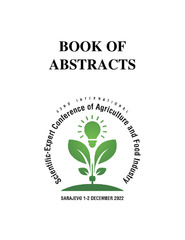Приказ основних података о документу
NUTMEG SPICE – SOURCE OF NATURAL ANTIOXIDANTS
| dc.creator | Vuković, Sandra | |
| dc.creator | Moravčević, Đorđe | |
| dc.creator | Vujošević, Ana | |
| dc.creator | Kilibarda, Sofija | |
| dc.creator | Milinčić, Danijel | |
| dc.creator | Biber, Lejla | |
| dc.creator | Kostić, Aleksandar Ž. | |
| dc.date.accessioned | 2024-03-20T11:24:10Z | |
| dc.date.available | 2024-03-20T11:24:10Z | |
| dc.date.issued | 2022 | |
| dc.identifier.uri | http://aspace.agrif.bg.ac.rs/handle/123456789/6908 | |
| dc.description.abstract | Nutmeg is the spice from evergreen-tree Myristica fragrans from family Myristicaceae, obtained by peeling seeds from cover (mace). Nutmeg is sold as whole seed or ground spice, and is also a raw material for several commercial products: essential oil and nutmeg butter. The modern lifestyle in many ways contributes to the generation of free radicals and other reactive oxygen species (ROS), which leads to the appearance of oxidative stress in the human body. Since oxidative stress is found in the pathophysiology of many current diseases, (cardiovascular, diabetes, cancer, atherosclerosis) supplementation of products rich in antioxidants is resorted to. Plants, including spices, are recognized as an excellent source of natural antioxidants. Many studies have reported a wide range of pharmacological properties of nutmeg spice, including antioxidant, hepatoprotective, anti-inflamatory, antifungal, antibacterial. The antioxidant activity of nutmeg is attributed to the rich content of total phenolics, especially caffic acid and catechin. In this research, local purchased ground nutmeg spice was used to prepare extracts in 80% acetone and warm water (50 ºC), using ultrasound assisted extraction and without ultrasound assisted extraction technique. The aim of study was to determine antioxidant activity of nutmeg spice by using spectrophotomtric assays: 2,2-diphenyl-1-picrylhydrazyl (DPPH⦁ ) radical scavenging, cupric reducing antioxidant capacity (CUPRAC), ferric reducing power (FRP) and in vitro phosphomolybdenum assay. The highest antioxidant capacity was observed in acetone extract obtained by UAE, in DPPH⦁ assay (57.49 ± 5.01 % Inh). The lowest antioxidant capacity was measured in water extracts, in FRAP assay, and obtained results was same for both extraction techniques (0.20 ± 0.00 mg/g ascorbic acid equivalents (AAE)). In general, acetone extracts exhibited a stronger antioxidant activity compared to water extracts, regardless of the applied extraction technique. | sr |
| dc.language.iso | en | sr |
| dc.rights | openAccess | sr |
| dc.rights.uri | https://creativecommons.org/licenses/by/4.0/ | |
| dc.source | 32nd Scientific-Expert Conference of Agriculture and Food Industry- Book of Abstracts | sr |
| dc.subject | antioxidant capacity | sr |
| dc.subject | Myristica fragrans | sr |
| dc.subject | nutmeg | sr |
| dc.subject | spice | sr |
| dc.title | NUTMEG SPICE – SOURCE OF NATURAL ANTIOXIDANTS | sr |
| dc.type | other | sr |
| dc.rights.license | BY | sr |
| dc.citation.epage | 43 | |
| dc.citation.spage | 43 | |
| dc.identifier.fulltext | http://aspace.agrif.bg.ac.rs/bitstream/id/26319/NUTMEG_SPICE_2022.pdf | |
| dc.identifier.rcub | https://hdl.handle.net/21.15107/rcub_agrospace_6908 | |
| dc.type.version | publishedVersion | sr |


